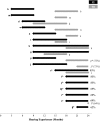Consonant Acquisition in Young Cochlear Implant Recipients and Their Typically Developing Peers
- PMID: 28474085
- PMCID: PMC5544364
- DOI: 10.1044/2016_AJSLP-16-0073
Consonant Acquisition in Young Cochlear Implant Recipients and Their Typically Developing Peers
Abstract
Purpose: Consonant acquisition was examined in 13 young cochlear implant (CI) recipients and 11 typically developing (TD) children.
Method: A longitudinal research design was implemented to determine the rate and nature of consonant acquisition during the first 2 years of robust hearing experience. Twenty-minute adult-child (typically a parent) interactions were video and audio recorded at 3-month intervals following implantation until 24 months of robust hearing experience was achieved. TD children were similarly recorded between 6 and 24 months of age. Consonants that were produced twice within a 50-utterance sample were considered "established" within a child's consonant inventory.
Results: Although the groups showed similar trajectories, the CI group produced larger consonant inventories than the TD group at each interval except for 21 and 24 months. A majority of children with CIs also showed more rapid acquisition of consonants and more diverse consonant inventories than TD children.
Conclusions: These results suggest that early auditory deprivation does not significantly affect consonant acquisition for most CI recipients. Tracking early consonant development appears to be a useful way to assess the effectiveness of cochlear implantation in young recipients.
Figures






Similar articles
-
Factors affecting consonant production accuracy in children with cochlear implants: Expressive vocabulary and maternal education.Int J Lang Commun Disord. 2024 Nov-Dec;59(6):2312-2332. doi: 10.1111/1460-6984.13075. Epub 2024 Jun 27. Int J Lang Commun Disord. 2024. PMID: 38934649
-
Beginning to talk like an adult: increases in speech-like utterances in young cochlear implant recipients and typically developing children.Am J Speech Lang Pathol. 2013 Nov;22(4):591-603. doi: 10.1044/1058-0360(2013/12-0058). Epub 2013 Jun 28. Am J Speech Lang Pathol. 2013. PMID: 23813203 Free PMC article.
-
Consonant production accuracy in young cochlear implant recipients: developmental sound classes and word position effects.Am J Speech Lang Pathol. 2012 Nov;21(4):342-53. doi: 10.1044/1058-0360(2012/11-0118). Epub 2012 Jul 30. Am J Speech Lang Pathol. 2012. PMID: 22846882
-
Vocalizations of infants with hearing loss compared with infants with normal hearing: Part I--phonetic development.Ear Hear. 2007 Sep;28(5):605-27. doi: 10.1097/AUD.0b013e31812564ab. Ear Hear. 2007. PMID: 17804976
-
Consonant and Vowel Identification in Cochlear Implant Users Measured by Nonsense Words: A Systematic Review and Meta-Analysis.J Speech Lang Hear Res. 2018 Apr 17;61(4):1023-1050. doi: 10.1044/2018_JSLHR-H-16-0463. J Speech Lang Hear Res. 2018. PMID: 29623340
Cited by
-
The Relationship Between the Onset of Canonical Syllables and Speech Perception Skills in Children With Cochlear Implants.J Speech Lang Hear Res. 2020 Feb 26;63(2):393-404. doi: 10.1044/2019_JSLHR-19-00158. Epub 2020 Feb 11. J Speech Lang Hear Res. 2020. PMID: 32073331 Free PMC article.
-
Grammatical Abilities in Young Cochlear Implant Recipients and Children With Normal Hearing Matched by Vocabulary Size.Am J Speech Lang Pathol. 2018 May 3;27(2):751-764. doi: 10.1044/2018_AJSLP-16-0164. Am J Speech Lang Pathol. 2018. PMID: 29625430 Free PMC article.
References
-
- Blamey P. J., Barry J. G., & Jacq P. (2001). Phonetic inventory development in young cochlear implant users 6 years postoperation. Journal of Speech, Language, and Hearing Research, 44, 73–79. https://doi.org/10.1044/1092-4388(2001/007) - PubMed
-
- Bouchard M. E. G., Le Normand M. T., & Cohen H. (2007). Production of consonants by prelinguistically deaf children with cochlear implants. Clinical Linguistics & Phonetics, 21, 875–884. https://doi.org/10.1080/02699200701653634 - PubMed
-
- Chin S., & Pisoni D. B. (2000). A phonological system at 2 years after cochlear implantation. Clinical Linguistics & Phonetics, 14, 53–73. https://doi.org/10.1080/026992000298940 - PMC - PubMed
-
- Connor C. M., Craig H. K., Raudenbush S.W., Heavner K., & Zwolan T. A. (2006). The age at which young deaf children receive cochlear implants and their vocabulary and speech production growth: Is there added value for early implantation? Ear and Hearing, 27, 628–644. https://doi.org/10.1097/01.aud.0000240640.59205.42 - PubMed
-
- Dettman S. J., Dowell R. C., Choo D., Arnott W., Abrahams Y., Davis A., … Briggs R. J. (2016). Long-term communication outcomes for children receiving cochlear implants younger than 12 months: A multicenter study. Otology & Neurotology, 37, e82–e95. https://doi.org/10.1097/MAO.0000000000000915 - PubMed
MeSH terms
Grants and funding
LinkOut - more resources
Full Text Sources
Other Literature Sources
Medical

